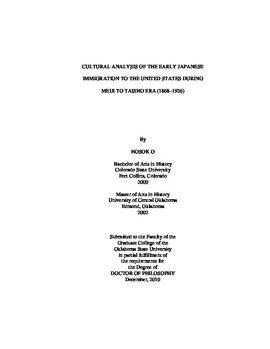| dc.contributor.advisor | Petrin, Ronald A. | |
| dc.contributor.author | O, Hosok | |
| dc.date.accessioned | 2013-11-26T08:24:18Z | |
| dc.date.available | 2013-11-26T08:24:18Z | |
| dc.date.issued | 2010-12 | |
| dc.identifier.uri | https://hdl.handle.net/11244/6783 | |
| dc.description.abstract | Scope and Method of Study: Focusing on the years between 1868 and 1926 during which Japan underwent drastic socioeconomic, political, and cultural changes, this study traces the "pushes" (forces that caused the people to leave Japan) and "pulls" (things that attracted the people to go to Hawaii and the United States) of Japanese immigration. Utilizing a variety of primary sources such as Japanese and American newspapers, Nihon Gaiko Bunsho, Reports of the Immigration Commission, Japanese and the U.S. census records, and works of the Meiji intellectuals, this study offers cultural analysis of the Japanese immigration to Hawaii and the United States. | |
| dc.description.abstract | Findings and Conclusions: Following the opening of Japan, the Japanese immigration was a byproduct of nation's rapid modernization which created a modern nation-state. Unlike colonized countries, modernization/Westernization was voluntary for the Japanese and was a way of achieving the national policy called fukoku kyohei. Nakahama Manjiro, a castaway who obtained navigation and shipbuilding skills in the United States, not only inspired the young Japanese but also facilitated Japan's modernization process. Nationalistic leaders promoted fukoku kyohei to equalize with the West by repealing "unequal treaties." To pursue this policy, the government fostered the growth of industries--Mitsubishi played an important role in developing the nation's maritime industry and the Imperial Navy. While actively adopting advanced western science and technology, Japanese cultural values were emphasized for implanting the institutionalized nationalism. The Meiji intellectuals like Fukuzawa Yukichi contributed to the government's aim by indoctrinating the superiority of Japanese over other Asians. Significantly, the cooperation between the government and industries for achieving fukoku kyohei both directly and indirectly resulted in a large-scale overseas emigration. The emigrants' remittance became an important source of foreign currencies required for carrying out expensive modernization. Meanwhile, the Japanese emigration alleviated the labor shortage problem in Hawaii and the United States. This study illustrates that the government with the help of certain individuals created a climate, which made immigration possible. The socioeconomic conditions of the emigrants as well as the national policy and attitude towards the West made the United States the place to go as opposed to China. | |
| dc.format | application/pdf | |
| dc.language | en_US | |
| dc.rights | Copyright is held by the author who has granted the Oklahoma State University Library the non-exclusive right to share this material in its institutional repository. Contact Digital Library Services at lib-dls@okstate.edu or 405-744-9161 for the permission policy on the use, reproduction or distribution of this material. | |
| dc.title | Cultural analysis of the early Japanese immigration to the United States during Meiji to Taisho era (1868-1926) | |
| dc.contributor.committeeMember | Jiang, Yonglin | |
| dc.contributor.committeeMember | Bracy, R. Michael | |
| dc.contributor.committeeMember | Logan, Michael F. | |
| dc.contributor.committeeMember | Van Delinder, Jean | |
| osu.filename | O_okstate_0664D_11126.pdf | |
| osu.accesstype | Open Access | |
| dc.type.genre | Dissertation | |
| dc.type.material | Text | |
| dc.subject.keywords | fukuzawa | |
| dc.subject.keywords | hawaii | |
| dc.subject.keywords | immigration | |
| dc.subject.keywords | japan | |
| dc.subject.keywords | meiji | |
| dc.subject.keywords | taisho | |
| thesis.degree.discipline | History | |
| thesis.degree.grantor | Oklahoma State University | |
